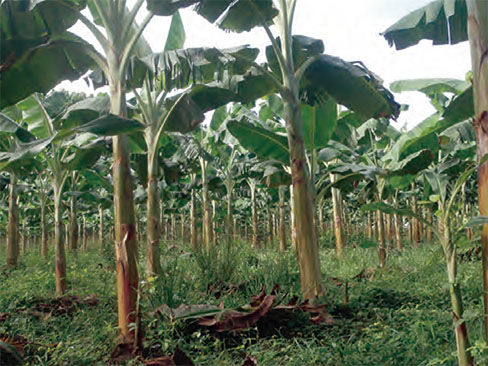Banana production in Alto Apure
Abstract
Bananas and plantains are of great economic importance in Venezuela, being considered as food of high national consumption located at 44.41 kg / person / year. The national production potential is 18t / ha. In Venezuela, the cultivation of bananas has increased in importance in the last 10 years, due to the decrease in the harvested area of bananas, as a consequence of the problems with the export market. For the year 2012, the planted area of banana cultivation in the country was approximately 50,000 hectares (FAOSTAT, 2014).
In Alto Apure, banana production for 2008 was 6,353 tons (VII National Agricultural Census). This crop, from the social point of view, is associated with regional consumption, which makes it a traditional product included in the basic diet of the high-pressure town, as it is an indispensable ingredient of Creole foods. In addition, in rural areas, a large number of families have a direct or indirect dependence on this crop, which generates at least 3,000 jobs.
Given the characteristics of the traditional planting system in Alto Apure, a good production of the banana crop, Musa AAB cv. Hartón plantain subgroup, begins with the use of certified or controlled seed, which ensures that a material free of pests and diseases is brought to the field, and preferably that it comes from high-altitude communities, as well as the adequate application of good agronomic management.
Banana production in lowland conditions in the upper area of Alto Apure has been affected by various factors, among which are mentioned: weeds, pests and diseases, climatic factors (floods) and poor fertilization. This has led to a decrease in production and the sowing area of the crop, reaching very low local averages of 10 t / ha (2013 Municipal Production Census). Today the production of this important item is recovering, applying very carefully good agricultural practices and strict agronomic management to the crop, where results have been obtained in the 2014-2016 period with yields ranging between 20 and 25 t / ha.
References
Alarcón A, R. Ferrera-Cerrato. 2000. Biofertilizantes:Importancia y utilización en la Agricultura. Agric. Tec. Mex. 26: 191-203 pp.
Altieri, M. 1999. Agroecología. Bases científicas para una agricultura sustentable. Ed. Nordan Comunidad. Montevideo, Uruguay. 325 p.
Arango, M.E. 2002. Alternativas de manejo para el control biológico de Sigatoka Negra (Mycosphaerella fijiensis Morelet) en el cultivo del banano (Musa AAA) 130-134 pp. Memorias XV Reunión Internacional Asociación para la Cooperación en Investigaciones de Bananos en el Caribe y la América Latina (ACORBAT), Cartagena de Indias, Colombia. Oct. 27-nov 02 de 2002. Asociación de Bananeros de Colombia (AUGURA), Medellín, Colombia.


